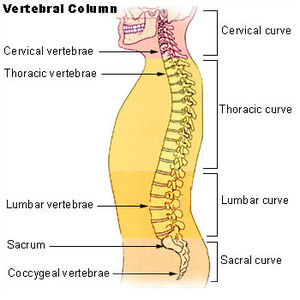
The changes in a human pelvis that allow humans to walk upright also made bearing children unusually more dangerous than the rest of the animal kingdom. Additionally, the lumbar curve in the lower back, which helps humans maintain balance, is more vulnerable to pain and injury.
Lordosis is the normal inward lordotic curvature of the lumbar and cervical regions of the human spine.[1] The normal outward (convex) curvature in the thoracic and sacral regions is termed kyphosis or kyphotic. The term comes from the Greek lordōsis, from lordos ("bent backward").[2]
Lordosis in the human spine makes it easier for humans to bring the bulk of their mass over the pelvis. This allows for a much more efficient walking gait than that of other primates, whose inflexible spines cause them to resort to an inefficient forward leaning "bent-knee, bent-waist" gait. As such, lordosis in the human spine is considered one of the primary physiological adaptations of the human skeleton that allows for human gait to be as energetically efficient as it is.
| Lordosis | |
|---|---|
 | |
| Diagram showing normal curvature (posterior concavity) of the cervical (neck) and lumbar (lower back) vertebral column (spine). | |
Kyphosis can be called roundback or Kelso's hunchback.
While most cases of kyphosis are mild and only require routine monitoring, serious cases can be debilitating. High degrees of kyphosis can cause severe pain and discomfort, breathing and digestion difficulties, cardiovascular irregularities, neurological compromise and, in the more severe cases, significantly shortened life spans.
These types of high-end curves typically do not respond well to conservative treatment and almost always warrant spinal fusion surgery, which can restore the body's natural degree of curvature.